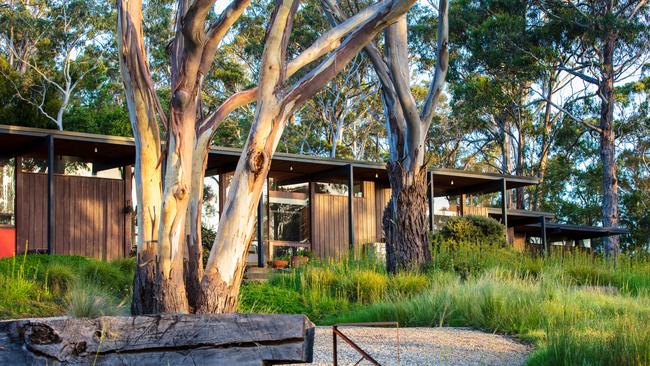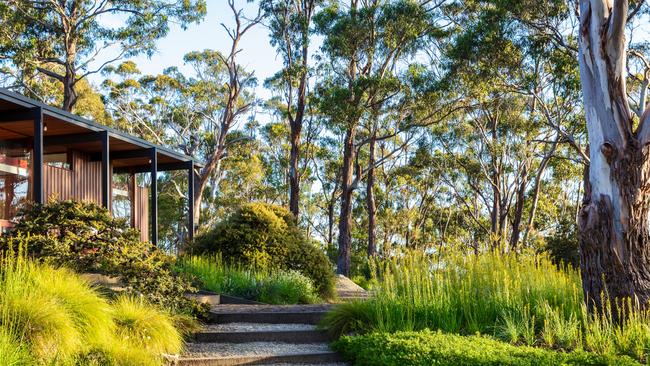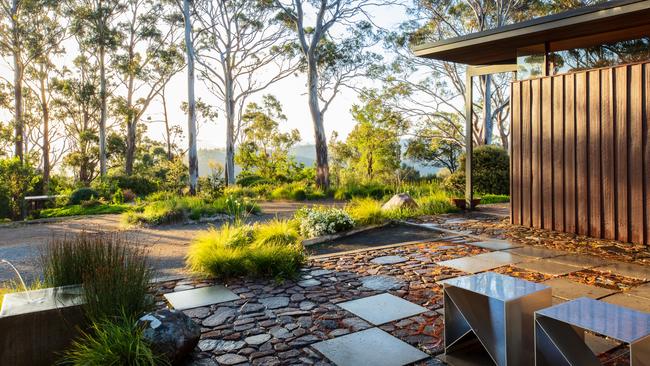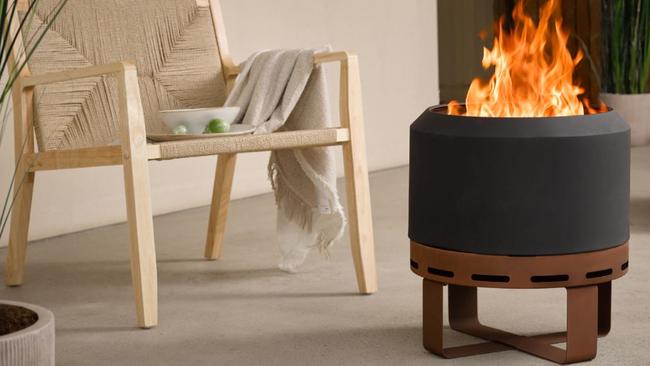How the experts create the garden of their dreams
What does the home garden of the former Royal Tasmanian Botanical Gardens’ deputy director look like? Time to take a tour.

“If we had a credo for the garden, it would be that it has to belong in the landscape and respond to the landscape,” says Mark Fountain, who with his wife Keryn has crafted this sustainable native garden just outside Hobart. It features in Visionary: Gardens and Landscapes for Our Future by Australian photographer Claire Takacs (Hardie Grant, $70), which explores how garden design is evolving in the face of climate change.
The 2ha property, on the slopes of Mount Rumney, has views west to Mount Wellington, north to the Meehan Range and south to the Derwent River and distant Southern Ocean. “We are framed by blue gums on one side and manna gums on the other,” says Keryn. “We wanted to maintain that sense of place, so that what we grew blended with the native flora.”
Since buying the property nearly 30 years ago, the once traditional native garden has gradually been re-formed using a deliberately limited palette of mostly drought-tolerant Tasmanian species. The couple made decisions slowly, guided by their shared creative passions. Mark, a former deputy director of the Royal Tasmanian Botanical Gardens, has designed with and grown plants most of his life, while Keryn is an artist. They wanted the garden to complement the minimalistic style of the mid-century house; their travels in Japan also influenced their design choices.

Generous swathes of ground covers such as creeping boobialla (Myoporum parvifolium) and native grasses are used to visually simplify but strengthen the design. “We both have art school backgrounds so we look at the garden from a design sensibility,” says Mark. In spring and summer, a mix of perennials with delicate flowers pop up after rain. These include native daisy (Brachyscome), Wahlenbergia and native leek (Bulbine bulbosa), propagated from seed collected on the hillside. The shrub layer includes correas and westringias, with hop bush (Dodonaea viscosa) and Bursaria spinosa forming characterful small trees. Endemic velvet bush (Lasiopetalum micranthum) is also used for low, spreading blocks of interesting foliage, while massed lomandras and dianellas add texture.
Everything has to be tough. The soil is rocky dolerite, difficult to garden, but a good source of stone for garden projects. “Plants grow well in it, but slow and tough,” says Mark. “We don’t fertilise anything, as that just attracts wallabies to eat the soft new foliage.” They protect new plantings until they’re big enough to cope with browsing. As it’s a low rainfall area, Mark has built some creative water features for the wildlife. Birds bathe in the reflecting pond and a huge range of animals, from wallabies to black cockatoos and flocks of blue wrens, drink from the water sources.

In the middle of the garden, an area they call the Marsupial Lawn is a small native grassland with some rare and threatened species, which has remained undisturbed by the few previous owners of the property. “That’s pretty rare I’d say, so we leave it alone too,” says Mark. Wallabies, bettongs, potoroos and echidnas are all regular visitors.
Mark and Keryn estimate that the garden area they cultivate, which includes an enclosed vegetable garden, is about one third of the block. They refuse to use herbicides or pesticides, saying they don’t want the garden to be perfect. “My gardening is really just raking up bark and leaf litter, and cleaning up dropped branches,” laughs Keryn. “It’s a year-round job but helps keep it firesafe.”
“There are days when you don’t do anything – you just watch,” says Mark. “It’s like being in a painting,” adds Keryn. “The changes of light through the day are mesmerising.”
Q&A
My buffalo lawn is infested with moss and another low weed, especially in winter. I’ve treated with diluted Roundup but it leaves large bare patches. Is there a weedkiller that doesn’t do this?
Jim Nelson, Sydney
Selective lawn herbicides will kill broadleaf weeds but not lawn grasses; ensure you choose one suitable for buffalo grass. Moss loves shade, and its growth indicates that your soil is acidic, compacted, poorly drained and of low fertility. Prune shrubs and trees to get more sunlight. Test soil pH and add lime or dolomite to bring it to 6.5-7 pH. Aerate or core the lawn. Fertilise lawn in autumn to get it growing strongly into winter. To kill moss, spread 30g iron sulphate mixed with 70g gypsum per square metre; don’t overdo it, and beware iron can stain paths. Or use products containing the moss and algae killer benzalkonium chloride, such as Surrender Mosskiller or Wet and Forget.
What is the sticky, sugary sap on the leaves of my moth orchid – and what is the remedy?
Beryl Burke, Adelaide
Honeydew is excreted by sap-sucking insects such as scale and mealybugs. Treat the pests by hand removal (dab mealybugs with a cotton tip dipped in methylated spirits) or spray with Eco-Neem, repeating after two weeks.
My indoor Ficus is over 2m tall with three thick stems. Can I tip the stems to shorten it and make it bushier, or do I need to cut at the base?
Geraldine Robinson, by email
Generally, growth comes from where you prune to, so tip pruning the stems will encourage growth around the edges. If you want new growth lower down, you’d need to prune back into bare stems – best done in spring – and allow time for recovery. Depending on the plant’s form, you might prune one stem hard each year. It would probably benefit from re-potting to stimulate new growth.
Send your questions to helenyoungtwig@gmail.com The best question for June wins an Aurus 450 Low Smoke Fire Pit with cover, valued at $149. bunnings.com.au
More Coverage








To join the conversation, please log in. Don't have an account? Register
Join the conversation, you are commenting as Logout